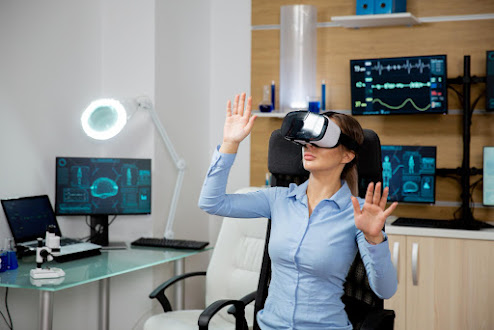Virtual Reality in Healthcare: The Perspective Revolution
VR is fast emerging as a transformative force in various sectors, its biggest impact being in the world of healthcare. Simulation-based medical training, which used to be confined to physical settings and real-life scenarios, is undergoing a major change spearheaded by VR technology. The main reason is the astonishing ability to create immersive and easily replicable scenarios that drive both behavioral and procedural training.
What's more, the technology injects an ‘Aha’ moment into the learning process. The gamified experience enthralls learners and promotes frequent practice, reducing costly mistakes and enhancing performance in the real world. Importantly, this shift to VR can ease the financial strain for institutions—no small feat in a climate where simulation-based learning often incurs prohibitive costs.
As medical education evolves at breakneck speed, integrating novel techniques such as problem-based learning and communication-skills training, VR steps in as a natural ally, transforming how we nurture the doctors of tomorrow.
As virtual reality (VR) permeates various industries, its impact as an immersive learning tool is gaining substantial recognition. The VR application in healthcare has been shown to outperform traditional screen-based techniques and improve surgical precision, efficiency, and patient outcomes. The study by Frontiers in Virtual Reality compared low-cost cardboard viewer VR (CVVR) with high-end integrated headset VR (IHVR) for training radiation oncology residents in intracavitary procedures. Surprisingly, both methods proved equally effective, indicating that cost-effective VR solutions can indeed deliver powerful learning experiences. This revelation debunks the myth of the financial burden of implementing VR in medical training. The potential applications of VR in medical education and training seem boundless, as described by authors in Future Healthcare Journal. By crafting lifelike, dynamic scenarios in virtual hospitals, complete with realistic patients, colleagues, and families, VR enables learners to engage in a truly immersive environment.
For example, virtual emergency departments can help learners assess conditions like chest pain by taking medical histories, performing examinations, making diagnoses, and even administering treatments. The interactive nature of VR allows for real-time adaptation of patient observations, test results, and conversations, adding layers of complexity and realism.
As VR technology continues to evolve and demonstrate its value, it becomes increasingly clear that the fusion of excitement and practical application can redefine the landscape of medical education and training, pushing the boundaries of what is possible in preparing the next generation of healthcare professionals.
A great example of this revolution is the world of laparoscopy. It is witnessing a remarkable transformation as virtual reality (VR) emerges as a powerful training tool for healthcare professionals. Despite limited training opportunities in this area, a groundbreaking study found that, after just 6 weeks of VR in medical training, OR nurses developed laparoscopic skills on par with medical residents and postgraduate students. This innovative approach not only bridges the skills gap among healthcare providers but also holds the potential to improve patient outcomes and reduce surgical complications. Moreover, VR is making strides in behavioral health guidance, as demonstrated by Cincinnati Children's Hospital Medical Center's PREVENT curriculum. This immersive virtual environment effectively trains pediatric residents to provide behavioral health guidance for conditions such as substance dependence and eating disorders. Residents reported a high level of engagement and cognitive involvement, emphasizing the real-world applicability of the program.
The future will only increase the acceptance of VR in medical training. The integration of VR with artificial intelligence will enable educators to address widespread learning challenges more effectively. Furthermore, remote, collaborative learning could revolutionize the field, fostering a global healthcare system that transcends borders, cultures, and societies. The ACGME's Assessment Guidebook currently advocates for VR's use in medical education, signaling a promising future for VR as a routine training tool for residents. As the technology continues to evolve, we can expect even more realistic and immersive experiences that will shape the next generation of healthcare professionals.



.jpg)
Comments
Post a Comment